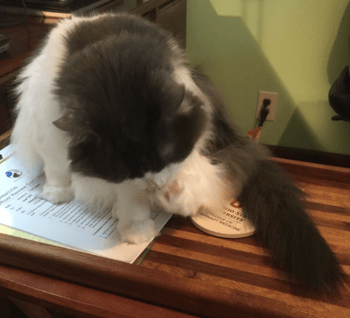Here, kitty-kitty. It’s time for nail trimming.
Does your cat give you a suspicious look or disappear when you want to trim their nails? Are you worried about cutting too much?
Learning how to safely trim nails is an important part of being a pet parent, and most cats can get used to it — if you start early enough and proceed with patience.
Here are some tips on how to trim your cat’s nails from some experts at Washington State University’s Veterinary Teaching Hospital.
Why Trim Nails?
Claws are some of the most important tools that cats have for scratching, climbing, and defending themselves. Outdoor cats will also use them to help them catch prey like mice. They keep these retractable tools/weapons hidden until they need them.
Cats’ nails are always growing. Outdoors, cats keep their nails short by scratching on trees and climbing. But even if you have a good scratching post, an indoor cat will need regular nail trims.
How Often?

According to Petmd.com, cats should get their nails trimmed every 10 days to two weeks so they don’t get stuck in clothing, carpets, or other soft surfaces.
Cats need to be able to retract their nails, and if their nails get overgrown and curved, they can grow back into their food pads, causing pain and trouble moving around. I have noticed that my cat Pearl will look like she’s trying to trim her own nails, and occasionally, I’ll find a shed claw in my house.
Not many cats look forward to getting their nails trimmed. But most can get used to it. When it comes to nail trimming, some of the basic principles of trimming dogs’ nails are also useful for cats.
Keep Calm, and Move Slowly
Animals pick up on our energy and stress, so take some deep breaths and choose a time when you’re not rushed. Here are a few ideas for calm nail trimming.
- Choose a comfortable place that has few distractions.
- Trim nails when a cat is sleepy (much of the day!) rather than when they are ready to play. After a meal might be a good time.
- Get your cat used to you touching their paws, pads, and claws. Practice pressing the paw to release the claw.
- Get your cat used to the sound of clippers by cutting a piece of uncooked spaghetti near them.
- Give them veterinary-approved treats and reassure them.
Once you have set the scene for a calm process, you should be able to cut a nail or two.
Tips for Safe Nail Trimming
- Learn from the pros. Ask your veterinarian, vet tech, or veterinary assistant to show you their techniques.
- Place your cat in your lap facing away from you with your forearm over their neck. You can gently wrap them in a towel if they get squirmy.
- Expose the claw. Cats have claws that retract, so before trimming, gently squeeze the toe to get the claw to peek out. When cats have white or pinkish claws, it is easy to see the quick, where the pink blood vessels and nerves are.
- Place the tip of the nail in the ring of the trimmer with the clipper even with the nail.
- Keep the cutting blade close to you and perpendicular to the nail.
- Avoid the quick. If you cut the quick, it will hurt and bleed, and your cat will be unhappy. Cut the claw 2 millimeters from the quick.
What Type of Clipper Is Best?
There are various types of nail clippers you can use, but most of us find the guillotine works better than a scissors type of trimmer for cats. Some people use human fingernail or toenail clippers, too. But get one for your cat - don’t share yours.
A cat’s dew claw is the one on the inner side that doesn’t touch the ground. It’s easier to use a scissors type trimmer to get the dew claw.
How Do You Know How Much to Cut?
The main goal in trimming is to avoid “the quick,” which is the part of the toenail that has blood vessels and nerves running through it.
Pets hate getting the quick cut - it’s painful! - and it’s messy since it can bleed. It’s easier to see with light-colored nails than dark-colored nails. If your cat has dark nails, proceed with caution and cut the claws in several stages to reduce the chance of nicking that sensitive area.
The good news is that all you really need to trim is the tip of their sharp nails. You can smooth out the nails with a nail file, if your cat still likes you enough to stick around.
Oops, I Clipped Too Much
If you do accidentally cut a nail too short, it’s good to have styptic powder handy. It takes a few minutes, but this powder will stop the bleeding if you apply it to the site of the cut. If you have corn starch but not styptic powder, then you can try that instead.
Nope, Not My Cat
Okay, it’s true. Not every cat is going to let their owner cut their nails. It costs money to have a groomer or clinic employee do it, but it might help keep the peace in your home.
Some animals get so stressed during nail trims that they need to be fully restrained or be medicated beforehand.
If you do go that route, be sure to choose someone who knows how to reduce stress in animals. As always, if you have questions about this important aspect of pet health, ask your veterinarian. They can also help you find resources that can help you meet the cost of veterinary care.
Together we can work to keep our beloved cats living happy, healthy lives.
